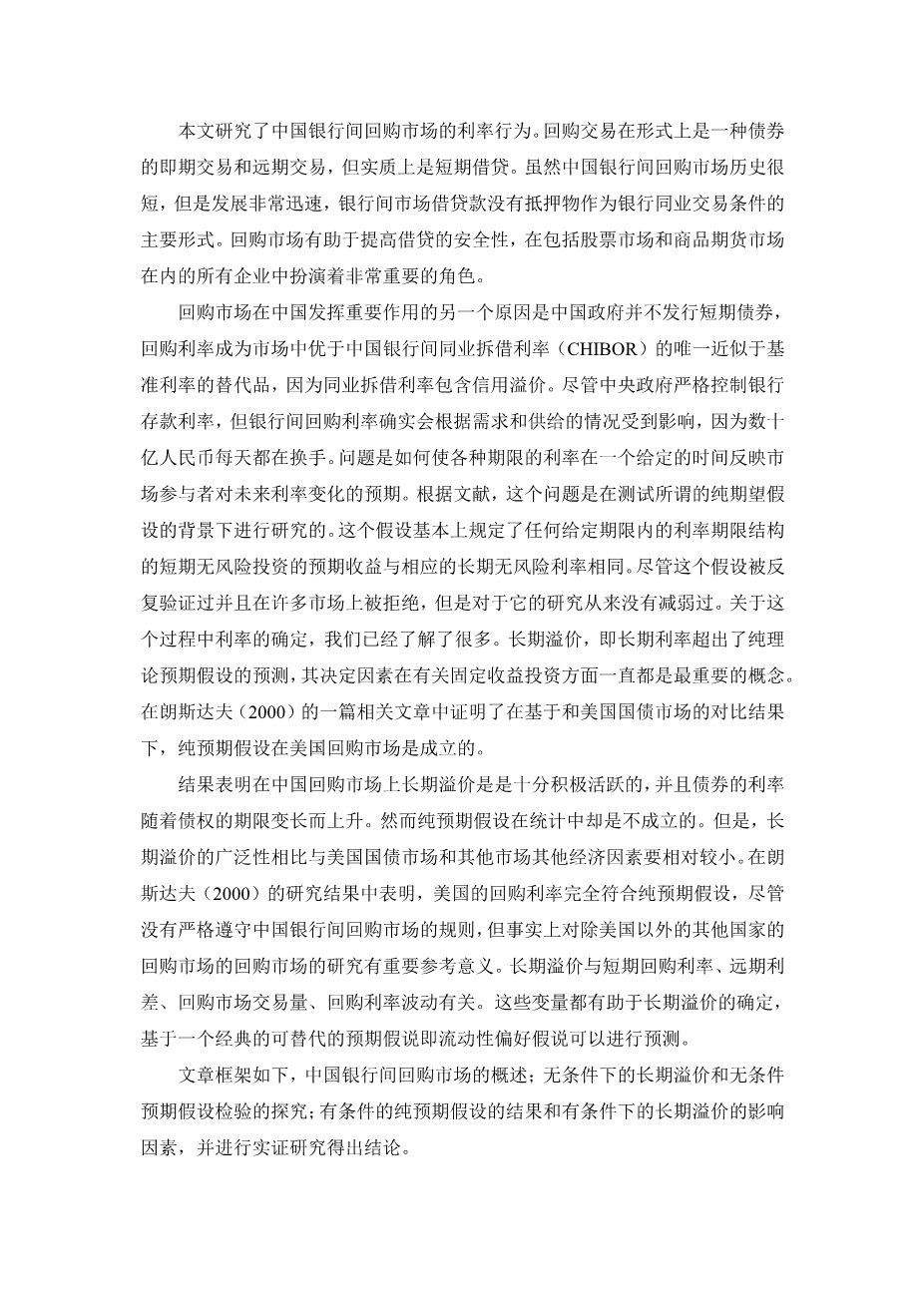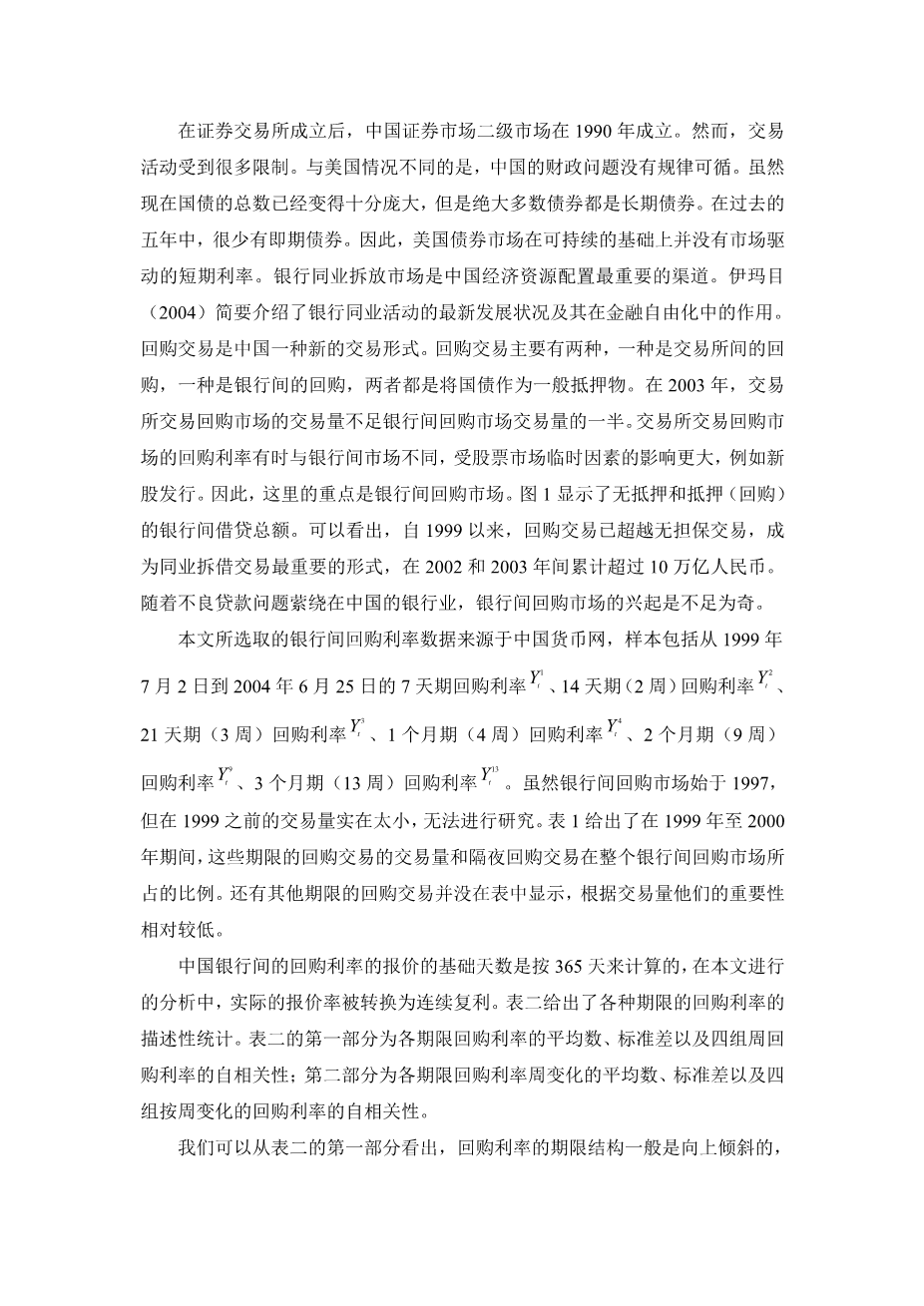出版源
《Journal of Futures Markets》, 2006, 26(2):153-167
This article studies the interest-rate behavior in the Chinese interbank repo market. A repo transaction is a pair of spot and forward transactions of some securities in form, but short-term borrowing and lending with col-lateral in essence. In spite of its short history, the interbank repo market in China has grown rapidly, taking over the interbank market for borrow-ing and lending without collateral as the major form of interbank transac-tions. The repo market facilitates borrowing and lending with enhanced safety and plays a very important role in all businesses, including the stock market and commodity futures markets.
The repo market in China is also important for another reason. Because the Chinese government does not issue short-term bonds, the repo rates become the only close substitutes of the benchmark risk-free rates in the market, better than the Chinese interbank-offered rates (CHIBOR) because CHIBOR contain credit premiums. Although the central government has tight control of the bank deposit rates, the inter-bank repo rates do fluctuate according to the conditions of demand and supply as billions of Renminbi (RMB, the Chinese currency) change hands on the daily basis. The question is how interest rates of various maturities at a given time reflect the expectations of the market partici-pants about future interest-rate changes. In accordance with the litera-ture, this question is examined in the context of testing the so-called pure expectations hypothesis. This hypothesis basically states that the term structure of interest rates at any given time is set such that the expected return on rolling over short-term risk-free investments is the same as the corresponding long-term risk-free rate. Although the hypothesis has been tested repeatedly and rejected frequently in many markets, the interest in reexamining it has never abated. Much has been learned about the determination of interest rates in the process. Term premiums, that is, longer-term rates in excess of what the pure expecta-tions hypothesis predicts, and their determinants have been the most important concept in decisions related to fixed-income investments. A particularly relevant work by Longstaff (2000) documents that the pure expectations hypothesis is supported in the U.S. repo market, in contrast with the findings based on the U.S. Treasury market.
The results show that term premiums in the Chinese repo market are positive and increasing with the term. The pure expectations hypothe-sis is statistically rejected. However, the magnitude of the term premi-ums is economically small relative to that found in the U.S. Treasury market and elsewhere. The finding in Longstaff (2000) that the U.S.repo rates conform to the pure expectations hypothesis, though not strictly observed in the Chinese interbank repo market, indeed has some merit for repo markets outside the United States. The term premiums are related to the short-term repo rate, to term spreads, to the trading volumes of repo markets, and to the volatility of the repo rates. All these variables contribute to the determination of term premiums, as the liquidity preference hypothesis, a classical alternative theory to the expectations hypothesis, predicts.
The article is organized as follows. The Chinese interbank repo market is described. The unconditional term premiums and unconditional tests of the pure expectation hypothesis are discussed. Results of the con-ditional test of the pure expectations hypothesis and the determinants of conditional term premiums are reported, and a conclusion is provided.
The secondary markets for Chinese Treasury securities officially began in 1990 when the securities exchanges were established. The trading activities, however, have been limited. Unlike the case of the United States, there are no regular cycles in Chinese Treasury issues. Although the total number of Treasury bonds has now become nontrivial, most bonds have long terms. There have been very few near-maturity bonds in the last 5 years. As a result, there are no market-driven short-term rates available from the Treasury market on a continual basis.
The interbank market has always been the most important channel for allocating resources across all sectors of the economy in China. Imam (2004) has a brief account of the recent development in interbank activities and its role in financial liberalization. Repo transactions are a recent phenomenon in China. There are two major repo markets. One is the market for exchange-traded repos and the other is the one for inter-bank repos. Both mainly use Treasuries as general collateral. The trading volume of the exchange-traded repo market was less than half of the interbank repo market in 2003. The repo rates prevailing in the exchange-traded repo market differ at times from those of the interbank market and are more affected by temporary factors in the stock market, such as new issues. Therefore the focus here is on the interbank repo market. Figure 1 shows the total amounts of interbank borrowing and lending without collateral and with collateral (repo). As can be seen, repo transactions have surpassed transactions without collateral since 1999 as the most important form of interbank borrowing and lending transactions, totaling more than 10 trillion RMB in 2002 and 2003. As the problem of nonperforming loans lingers in the China’s banking industry, the rise of the interbank repo market is no surprise.
The interbank repo rate data used in this study are from the www.chinamoney.com.cn Web site. The sample includes w
剩余内容已隐藏,支付完成后下载完整资料


英语译文共 3 页,剩余内容已隐藏,支付完成后下载完整资料
资料编号:[486526],资料为PDF文档或Word文档,PDF文档可免费转换为Word
以上是毕业论文外文翻译,课题毕业论文、任务书、文献综述、开题报告、程序设计、图纸设计等资料可联系客服协助查找。


